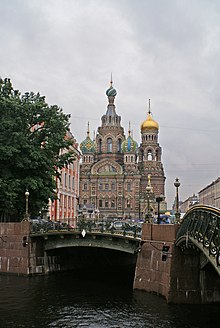
Nevsky Prospect is a main street located in the federal city of St. Petersburg in Russia. Its name comes from the Alexander Nevsky Lavra, the monastery which stands at the eastern end of the street, and which commemorates the Russian hero Prince Saint Alexander Nevsky (1221–1263). Following his founding of Saint Petersburg in 1703, Tsar Peter I planned the course of the street as the beginning of the road to Novgorod and Moscow. The avenue runs from the Admiralty in the west to the Moscow Railway Station and, after veering slightly southwards at Vosstaniya Square, to the Alexander Nevsky Lavra.
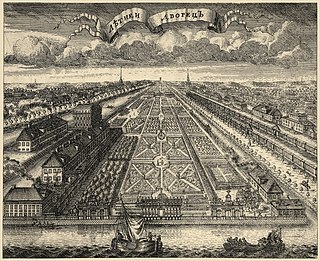
The Summer Garden is a historic public garden that occupies an eponymous island between the Neva, Fontanka, Moika, and the Swan Canal in downtown Saint Petersburg, Russia and shares its name with the adjacent Summer Palace of Peter the Great. Its inception dates back to early 18 century when Russia took these lands from Sweden in the Great Northern War. Being a monument of landscape architecture featuring original and copied sculptures of classical mythology characters, a former royal palace and a monument to the fable author Ivan Krylov, the garden is now a branch of the Saint Petersburg-based national art treasury Russian Museum.
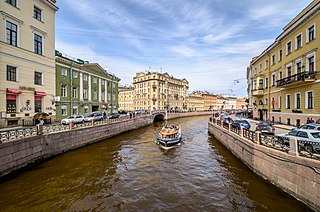
The Moyka is a secondary, in comparison with the Neva River in Saint Petersburg that encircles the central portion of the city, effectively making it an island or a group of islands, together with the Neva, the Fontanka, and canals including the Griboyedov and Kryukov. The river derives its name from the Ingrian word Muya for "slush" or "mire", having its original source in former swamp. It is 5 kilometres (3 mi) long and 40 metres (130 ft) wide.

Bank Bridge is a 25 m (82 ft) long pedestrian bridge crossing the Griboedov Canal near the former Russian Assignation Bank in Saint Petersburg, Russia. Similar to other bridges across the canal, the existing structure dates from 1826. The bridge engineer was Wilhelm von Traitteur, who conceived of a pedestrian separation structure suspended by cables. He was an engineer who also built other bridges over the Griboyedov Canal, Fontanka and Moika. The general management of the bridge construction was carried out by colonel E. A. Adam.
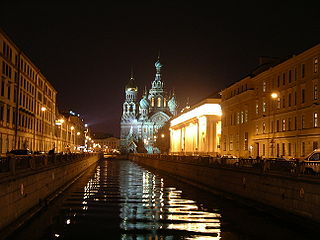
The Griboyedov Canal or Kanal Griboyedova is a canal in Saint Petersburg, constructed in 1739 along the existing Krivusha river. In 1764–90, the canal was deepened and the banks were reinforced and covered with granite.
Alexander Military Law Academy (1867–1917) was an educational institution in Russian Empire that provided military law education for officers of Russian Army and Fleet. It was established in 1867 and named after his founder, Emperor Alexander II of Russia in 1908. The Academy was situated in St. Petersburg by 96 Moika Embankment, along with many other institutions of military education.
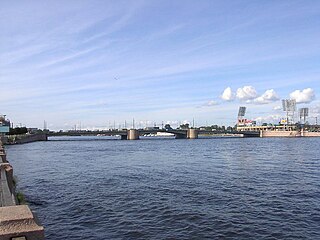
The Little Neva or Malaya Neva is the second largest distributary of the river Neva. The Neva splits into Great Neva and Little Neva near the Spit of Vasilievsky Island, in the historic centre of the city of Saint Petersburg.

Saint Isaac's Square or Isaakiyevskaya Ploshchad, known as Vorovsky Square between 1923 and 1944, in Saint Petersburg, Russia is a major city square sprawling between the Mariinsky Palace and Saint Isaac's Cathedral, which separates it from Senate Square. The square is graced by the equestrian Monument to Nicholas I.

The Blue Bridge is a 97.3-metre-wide (319 ft) bridge that spans the Moika River in Saint Petersburg, Russia. The Blue Bridge is the widest bridge in Saint Petersburg and is sometimes claimed to be the widest bridge in the world – a claim, however, that has not been recognized by international reference works, such as the Guinness World Records.

Green Bridge is a bridge across Moika River in Saint Petersburg, Russia. It was the first cast iron bridge in the city.

The Red Bridge, is a single-span bridge across the Moika River in Saint Petersburg, Russia. The bridge is a part of Gorokhovaya Street. The length of the bridge is 42 m; the width is 16.8 m.

The Pevchesky Bridge, also known as the Choristers' Bridge or Yellow Bridge, is a single-span bridge across the Moika River in Saint Petersburg, Russia. The bridge is a part of the Palace Square. The length of the bridge is 21 metres, and the width is 72 metres. It is the third-widest bridge in Saint Petersburg, after the Blue Bridge and Kazansky Bridge. Before the February Revolution, the term "Choristers' Bridge" was shorthand for the tsarist foreign ministry, just as the French foreign ministry is known as the Quai d'Orsay.
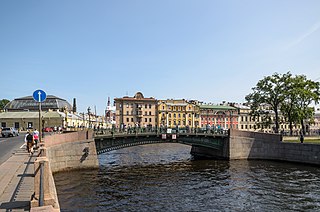
The First Engineer Bridge is one of several Russian bridges that span the Moika River in Saint Petersburg. The bridge is one of a group of four bridges located near the Mars Field, and opposite the main entrance to the Summer Garden, spanning the Moika River, the Fontanka River, and the Swan Canal in the historic center of the city. The First Engineer Bridge is one of the most decorative of Saint Petersburg's more than 500 bridges.

Postoffice Bridge is a pedestrian bridge across Moika River in Saint Petersburg, Russia. It is located near the central Postoffice building, from which it takes the name.
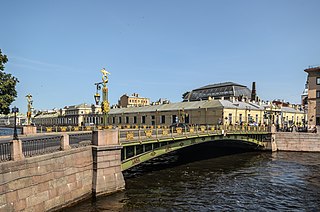
Panteleymonovsky Bridge is a bridge across the Fontanka River in Saint Petersburg, Russia. The bridge was erected in 1823 and was named after Panteleymonovskaya Street, which in turn was named after the nearby Church of St. Panteleimon (Pantaleon).

Winter Canal is a canal in Saint Petersburg, Russia, connecting Bolshaya Neva with Moika River in the vicinity of Winter Palace.

The Stroganov Palace is a Late Baroque palace at the intersection of the Moika River and Nevsky Prospect in St. Petersburg, Russia. The palace was built to Bartolomeo Rastrelli's designs for Baron Sergei Grigoriyevich Stroganov in 1753–1754. The interiors were remodeled by Andrei Voronikhin at the turn of the 19th century.

Alexeevsky Palace is a Revivalist palace compound on the bank of the Moika River in Saint Petersburg. It was erected in the mid-1880s as a private residence of Grand Duke Alexis and his family.
